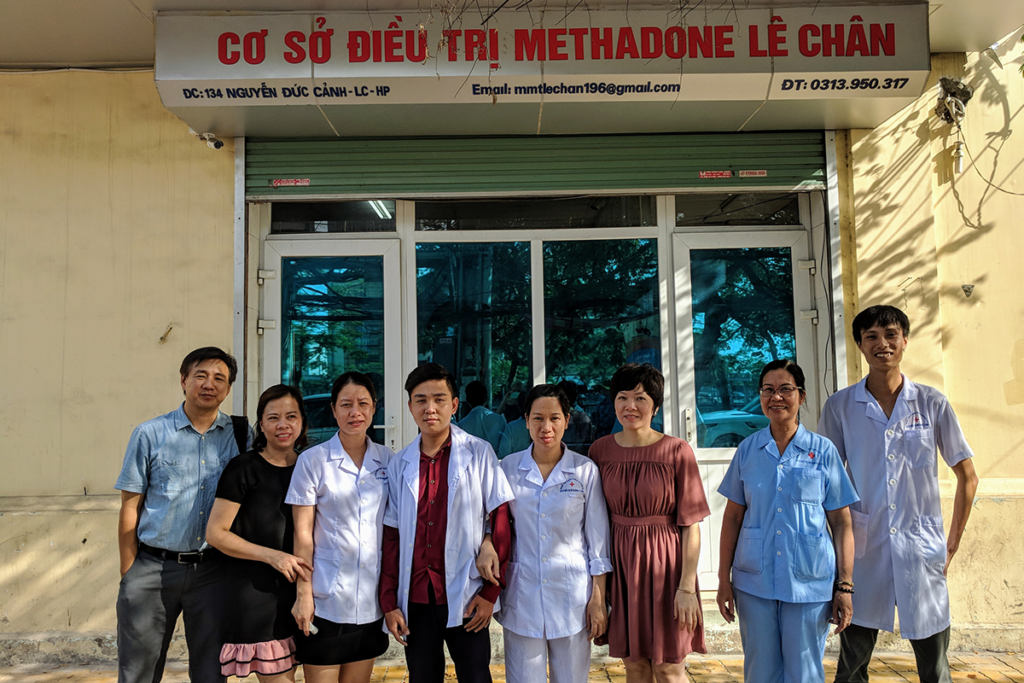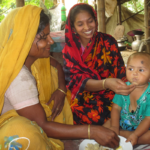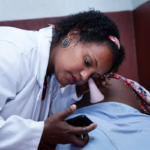It seems obvious that if an innovation addresses an existing problem it should be scaled-up. But, if you’ve worked in the development field, even for a brief period of time, you are aware that this is an oversimplification. Many evidence-backed, effective, innovative health interventions are never taken to scale. And if you’ve ever been directly involved in scale-up, you’re probably intimately aware that it’s not easy and the path is rarely, if ever, a straight or obvious one.
In an attempt to straighten this path, my co-researcher and I have started an FHI 360-funded research project to identify what factors influence the adoption and scale-up of innovative health interventions. The first challenge for this research is to select our study sample. That is, we need a sample of innovative health interventions that have been scaled-up in order to examine what common factors might help explain success. In this post, I outline the process we undertook to select four FHI 360-implemented projects in the Asia Pacific region to use as our study sample, and I describe both the innovations and the evidence of scale-up for each of the four.
To select our sample, we circulated a brief online survey to our Asia Pacific country directors. The survey asked respondents to identify any project implemented in their country in the past five years that was “innovative” and “scaled-up”.
For the purposes of our study and based on a review of existing literature, we defined innovation as “anything different than standard practice that has the potential for radical social, environmental, or economic impact” (Jonathan Tseun Yip Wong, Chief, Technology and Innovation, UN ESCAP, founding partner, Global Innovation Fund, Conversation with Phil Psilos, February 2018); and scale-up as “deliberate efforts to increase the impact of successfully tested health innovations in pilot or experimental projects to benefit more people and to foster policy and program development on a lasting basis (WHO, 2011).”
We received ten submissions, eliminated two that did not fit our definition of “innovation” or “scale-up,” and evaluated the remaining eight using four criteria:
- An intervention that addressed an existing health problem in a new or different way in the context where it was implemented.
- The degree to which the intervention was scaled-up. (We aimed to sample interventions that achieved different degrees of scale – from national to regional to global.)
- At least 3-5 staff members and partners who were involved in the implementation and scale-up of the intervention willing to participate in interviews.
- Sufficient documentation existed describing the intervention and/or the scale-up process.
We rated how closely each intervention aligned with these four selection criteria using a three-point-scale (3 = aligns closely; 2 = aligns somewhat; 1 = little or no alignment) and added the ratings to calculate a total score for the intervention (highest possible score = 12; lowest possible score = 4). The study team then met to review the rankings and select interventions, ensuring that those selected addressed a variety of health issues and that there was no more than one intervention per country.
The study team selected four interventions: methadone maintenance treatment in Vietnam, early infant diagnosis of HIV using dried blood spot testing in Nepal, a patient-centered care model for treating multi-drug resistant tuberculosis in China, and online-to-offline reservations for HIV testing in Thailand.
Here’s a bit more about each innovative intervention.
Methadone maintenance therapy, Vietnam
What is it?
Methadone maintenance therapy (MMT) refers to the long-term prescribing of methadone to former drug users as an alternative to the opioid on which they were dependent. It is paired with other medical and psychological support services like counseling and case management. Regulated and supervised use of methadone by recovering drug users can block euphoric effects of opioids and decrease cravings. The therapy currently treats over 1 million drug users in 80 countries worldwide.
How is it innovative?
According to the Ministry of Public Security, there were 210,751 drug addicts in Vietnam in 2016; 75.8% of whom were opioid dependent. Prior to the introduction of MMT clinics, the only rehabilitation option for drug users was compulsory treatment centers. Patients in these centers receive little medication assistance and are often subject to “labor therapy.” Compared to compulsory treatment, MMT has been shown to more effectively decrease or eliminate illicit drug use; decrease mortality and illness; improve clients’ emotional wellbeing; decrease crime, risky behaviors, and social costs associated with illicit drug use; and decrease HIV and Hepatitis C transmission (Vuong, et al., 2015).
How was it scaled-up?
Vietnam first introduced MMT in 2008 through a six-site pilot. Now there are over 300 MMT clinics throughout the country, providing services for over 53,000 patients (Vietnam Administration of HIV/AIDS Control, 2017). The sites are spread across 63 provinces and reach patients living in communes and remote areas who previously had to travel long distances to get to the nearest clinic. As the number of MMT clinics in Vietnam has increased, the number of residents in compulsory treatment centers has simultaneously decreased.
The government – at both the central and provincial level – has been instrumental in the introduction and scale-up of MMT. In 2009, the Prime Minister set a national goal to provide methadone treatment to over 80,000 drug users and allocated targets for each province in order to achieve this (Vuong, et al., 2015). The country is on its way to meeting that goal and now has a universal government-funded co-pay system to support costs of medication and treatment.
Early infant diagnosis of HIV using dried blood spot testing, Nepal
What is it?
In Nepal, FHI 360 helped introduce and scale-up early infant diagnosis of HIV using a revolutionary method for testing using dried blood spot (DBS) samples. Dried blood spot specimens do not require refrigeration, which facilitates safe, convenient, and affordable collection, shipment, and storage. The method can also be used to test for HIV in newly born children.
How is it innovative?
Early diagnosis and treatment of HIV can significantly improve the quality of life and life expectancy for HIV-infected children. Prior to the introduction of early infant diagnosis in Nepal in 2009, babies could not be tested for HIV until they were 18 months old. Additionally, unlike testing using dried blood samples, traditional testing methods require blood samples to be temperature controlled and are expensive to ship to diagnostic laboratories, making it difficult to provide testing services in remote and resource-limited areas.
How was it scaled-up?
This intervention was introduced in Nepal in three sites in 2009 as part of an FHI 360 project. The number of sample collection sites grew to six in 2011 through increased support from FHI 360 projects. For quality assurance purposes, samples collected in Nepal were initially sent for processing at the FHI 360 regional laboratory in Bangkok, Thailand. However, FHI 360 collaborated with local government partners to build the capacity of National TB Reference Laboratory staff, and testing is now done in country.
Successful introduction of early infant diagnosis using dried blood spots in Nepal along with global evidence supporting the intervention as safe, effective, and affordable led to the innovation garnering government support. The Nepal government backed the development of national guidelines and a training package for early infant diagnosis, incorporated the practice at the National Public Health Laboratory, and provided funding so that early infant diagnosis is now available free of charge throughout Nepal.
Patient-centered care model for treating multi-drug resistant tuberculosis, China
What is it?
The USAID Control and Prevention of Tuberculosis (CAP-TB) project implemented by FHI 360 is built on a patient-centered care model that makes patients key decision makers about their care and treatment and focuses on identifying and addressing their individual needs (Reynolds, 2009). The model strengthens universal access to information, education, counselling, and treatment services for multi-drug resistant (MDR) TB patients. Using a patent-centered care model increases the likelihood a TB patient adheres to and completes the full course of treatment (Dwamena, et al., 2012). This is particularly true for patients with drug-resistant TB, whose treatment can last up to two years and often has severe side effects (O’Donnell, et al., 2016).
How is it innovative?
The CAP-TB model uses innovative approaches like online support groups, community-based education and treatment, new diagnostic technologies, access to novel drugs and regimens, and a comprehensive clinical management platform. The model, supported by these components, contributes to increased case finding and treatment initiation, improved quality of care and treatment outcomes, reduced TB transmission, and ultimately, reduced incidence of MDR-TB.
How was it scaled-up?
USAID first piloted the CAP-TB model in 2012 in Yunnan Province, China, as part of an FHI 360 project. Aspects of the model have since spread to 19 sites across the country, and the CAP-TB project team is working with the National Center for Tuberculosis Control to refine the model and implement it in all 31 provinces through funding from the Chinese government.
In 2017, USAID selected China as one of four countries to take part in a global pilot of the U.S. National Action Plan for Combatting MDR-TB. Providing a patient-centered package of ancillary care services is a central component of the plan and, in China, the CAP-TB model is the backbone for these services. CAP-TB China was the first to complete an eight-month pilot of the National Action Plan in early 2018 and the team will share findings at conferences and workshops later this year. Participation in the pilot is paving the way for the CAP-TB model to have global influence on how MDR-TB is managed.
Online-to-offline reservations for HIV testing, Thailand
What is it?
In Thailand, FHI 360 developed and scaled-up a web-based application that allows people to make easy online reservations for HIV testing – known as an online-to-offline reservation. The approach targets high risk groups, primarily men who have sex with men (MSM), through tailored advertisements on websites and mobile applications that direct clients to a reservation website showing nearby clinics that provide HIV testing. These online advertisements and the reservation website are customized according to the website, application, or campaign where they are displayed.
How is it innovative?
The MSM population now spends a lot of time in online spaces – specifically on social media and dating websites and applications (Paz-Bailey, et al., 2017; Badal, et al., 2017). Reaching MSM in these spaces is not only convenient and appealing for users, it increases HIV testing among this group (Anand, et al., 2017).
Additionally, one of the most innovative aspects of the application is that it collects data that can inform and improve outreach and service provision. It provides statistics on which online promotions brought in the most clients for testing, and it allows program implementers to see what referrals are expected to come in, to prepare accordingly, and to record them as successfully completed. These data can also be reported to donors and used to garner support for program activities that were previously unmeasurable.
How was it scaled-up?
The online-to-offline reservation system was introduced with clinics in Bangkok in 2017 as part of the FHI 360-led LINKAGES project. The reservation website is now promoted throughout Thailand on numerous platforms and connects clients with clinics in four major cities across the country. In May 2018, FHI 360 launched the application in India, tailored to the specific country context and augmented with new features for easy risk assessment and recording client test results. Plans are underway to customize and launch the application in Vietnam, Nepal, and other LINKAGES countries by the end of the year.
Going forward
We will analyze these four interventions to better understand the factors influencing their adoption and scale-up using the following three methods to compare, contrast and synthesize our results:
- Code and analyze existing documentation (facts sheets, reports, guidelines, standard operating procedures, training manuals, advocacy materials, etc.) based on key themes and domains identified from literature.
- Conduct qualitative interviews with FHI 360 staff and implementing partners who were strategic players in the interventions’ implementation and scale-up.
- Conduct site visits to corroborate findings from the document analysis and interviews to determine if the intervention is being implemented as expected.
The project is still in the early stages, but stay tuned for our results in the months ahead!
Photo credit: FHI 360



